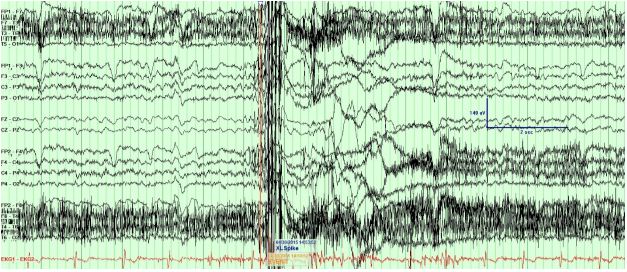- About ACNS
- Meetings
- Education
- Practice
- Research
- Advocacy
- Membership
Featured Case – June 2016
Contributed by Jong Woo Lee, MD, PhD
Brigham and Women’s Hospital, Boston, MA
A 55 year-old woman with Down Syndrome and Alzheimer’s dementia experienced her first generalized tonic clonic seizure followed by another seizure one month later. She was started on levetiracetam, but then developed jerking movements. She was frequently noted to be “catnapping” before a seizure or jerk. An EEG (Fig. 1) was obtained during which the patient experienced a brief, rapid startle-like extension of her upper extremities accompanied by a startled look on her face.
Initially, her seizures and myoclonic jerks were well controlled on levetiracetam, but she subsequently had breakthrough seizures, and was ultimately controlled on a moderate dose of levetiracetam and a low dose of valproic acid upon which her myoclonic jerks markedly improved. A repeat EEG 5 months later (Fig. 2) revealed markedly slower background activity and persistent interictal epileptiform discharges. Over the next 14 months, she deteriorated in function, with greater psychomotor slowing, difficulty standing/pivoting, and inability to follow commands. She was eventually transitioned to hospice care.
Question: What is the diagnosis?
Figure 1. Initial EEG

Figure 2. Repeat EEG

Answer & Discussion
The initial EEG demonstrated polyspike discharges associated with a myoclonic jerk, with a slow, mildly disorganized background. The second EEG demonstrated bilateral frontally predominant spikes and more marked background slowing.
This patient’s clinical and electrographic features are consistent with senile myoclonic epilepsy, also known as late onset myoclonic epilepsy in Down syndrome (LOMEDS). Alzheimer’s dementia occurs in up to 75% of patients with Down Syndrome, and approximately half of these experience seizures. Myoclonic jerks typically begin after the first occurrence of tonic-clonic seizures, can occur after awakening and may be sufficiently severe to lead to falls. Subsequently, there is rapid progression of dementia and death within several years. Myoclonic seizures frequently respond well to low-dose levetiracetam, valproic acid, and topiramate. LOMEDS is likely the most common form of progressive myoclonic epilepsy.
Further Reading: